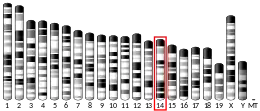Endonuclease VIII-like 2 is an enzyme that in humans is encoded by the NEIL2 gene.[4][5][6]
NEIL2 belongs to a class of DNA glycosylases homologous to the bacterial Fpg/Nei family. These glycosylases initiate the first step in base excision repair by cleaving bases damaged by reactive oxygen species and introducing a DNA strand break via the associated lyase reaction (Bandaru et al., 2002)[supplied by OMIM][6]
References
- 1 2 3 GRCm38: Ensembl release 89: ENSMUSG00000035121 - Ensembl, May 2017
- ↑ "Human PubMed Reference:". National Center for Biotechnology Information, U.S. National Library of Medicine.
- ↑ "Mouse PubMed Reference:". National Center for Biotechnology Information, U.S. National Library of Medicine.
- ↑ Hazra TK, Kow YW, Hatahet Z, Imhoff B, Boldogh I, Mokkapati SK, Mitra S, Izumi T (Aug 2002). "Identification and characterization of a novel human DNA glycosylase for repair of cytosine-derived lesions". J Biol Chem. 277 (34): 30417–20. doi:10.1074/jbc.C200355200. PMID 12097317.
- ↑ Das S, Chattopadhyay R, Bhakat KK, Boldogh I, Kohno K, Prasad R, Wilson SH, Hazra TK (Sep 2007). "Stimulation of NEIL2-mediated oxidized base excision repair via YB-1 interaction during oxidative stress". J Biol Chem. 282 (39): 28474–84. doi:10.1074/jbc.M704672200. PMC 2679419. PMID 17686777.
- 1 2 "Entrez Gene: NEIL2 nei like 2 (E. coli)".
Further reading
- Maruyama K, Sugano S (1994). "Oligo-capping: a simple method to replace the cap structure of eukaryotic mRNAs with oligoribonucleotides". Gene. 138 (1–2): 171–4. doi:10.1016/0378-1119(94)90802-8. PMID 8125298.
- Suzuki Y, Yoshitomo-Nakagawa K, Maruyama K, et al. (1997). "Construction and characterization of a full length-enriched and a 5'-end-enriched cDNA library". Gene. 200 (1–2): 149–56. doi:10.1016/S0378-1119(97)00411-3. PMID 9373149.
- Hartley JL, Temple GF, Brasch MA (2001). "DNA cloning using in vitro site-specific recombination". Genome Res. 10 (11): 1788–95. doi:10.1101/gr.143000. PMC 310948. PMID 11076863.
- Wiemann S, Weil B, Wellenreuther R, et al. (2001). "Toward a catalog of human genes and proteins: sequencing and analysis of 500 novel complete protein coding human cDNAs". Genome Res. 11 (3): 422–35. doi:10.1101/gr.GR1547R. PMC 311072. PMID 11230166.
- Takao M, Kanno S, Kobayashi K, et al. (2003). "A back-up glycosylase in Nth1 knock-out mice is a functional Nei (endonuclease VIII) homologue". J. Biol. Chem. 277 (44): 42205–13. doi:10.1074/jbc.M206884200. PMID 12200441.
- Strausberg RL, Feingold EA, Grouse LH, et al. (2003). "Generation and initial analysis of more than 15,000 full-length human and mouse cDNA sequences". Proc. Natl. Acad. Sci. U.S.A. 99 (26): 16899–903. Bibcode:2002PNAS...9916899M. doi:10.1073/pnas.242603899. PMC 139241. PMID 12477932.
- Bandaru V, Sunkara S, Wallace SS, Bond JP (2003). "A novel human DNA glycosylase that removes oxidative DNA damage and is homologous to Escherichia coli endonuclease VIII". DNA Repair (Amst.). 1 (7): 517–29. doi:10.1016/S1568-7864(02)00036-8. PMID 12509226.
- Dou H, Mitra S, Hazra TK (2004). "Repair of oxidized bases in DNA bubble structures by human DNA glycosylases NEIL1 and NEIL2". J. Biol. Chem. 278 (50): 49679–84. doi:10.1074/jbc.M308658200. PMID 14522990.
- Ota T, Suzuki Y, Nishikawa T, et al. (2004). "Complete sequencing and characterization of 21,243 full-length human cDNAs". Nat. Genet. 36 (1): 40–5. doi:10.1038/ng1285. PMID 14702039.
- Katafuchi A, Nakano T, Masaoka A, et al. (2004). "Differential specificity of human and Escherichia coli endonuclease III and VIII homologues for oxidative base lesions". J. Biol. Chem. 279 (14): 14464–71. doi:10.1074/jbc.M400393200. PMID 14734554.
- Bhakat KK, Hazra TK, Mitra S (2004). "Acetylation of the human DNA glycosylase NEIL2 and inhibition of its activity". Nucleic Acids Res. 32 (10): 3033–9. doi:10.1093/nar/gkh632. PMC 434438. PMID 15175427.
- Das A, Rajagopalan L, Mathura VS, et al. (2004). "Identification of a zinc finger domain in the human NEIL2 (Nei-like-2) protein". J. Biol. Chem. 279 (45): 47132–8. doi:10.1074/jbc.M406224200. PMID 15339932.
- Gerhard DS, Wagner L, Feingold EA, et al. (2004). "The status, quality, and expansion of the NIH full-length cDNA project: the Mammalian Gene Collection (MGC)". Genome Res. 14 (10B): 2121–7. doi:10.1101/gr.2596504. PMC 528928. PMID 15489334.
- Wiemann S, Arlt D, Huber W, et al. (2004). "From ORFeome to biology: a functional genomics pipeline". Genome Res. 14 (10B): 2136–44. doi:10.1101/gr.2576704. PMC 528930. PMID 15489336.
- Mehrle A, Rosenfelder H, Schupp I, et al. (2006). "The LIFEdb database in 2006". Nucleic Acids Res. 34 (Database issue): D415–8. doi:10.1093/nar/gkj139. PMC 1347501. PMID 16381901.
- Das A, Wiederhold L, Leppard JB, et al. (2007). "NEIL2-initiated, APE-independent repair of oxidized bases in DNA: Evidence for a repair complex in human cells". DNA Repair (Amst.). 5 (12): 1439–48. doi:10.1016/j.dnarep.2006.07.003. PMC 2805168. PMID 16982218.
- Broderick P, Bagratuni T, Vijayakrishnan J, et al. (2006). "Evaluation of NTHL1, NEIL1, NEIL2, MPG, TDG, UNG and SMUG1 genes in familial colorectal cancer predisposition". BMC Cancer. 6: 243. doi:10.1186/1471-2407-6-243. PMC 1624846. PMID 17029639.
- Katafuchi A, Matsubara M, Terato H, et al. (2007). "Damage specificity of human DNA glycosylases for oxidative pyrimidine lesions". Nucleic Acids Symp Ser (Oxf). 48 (48): 175–6. doi:10.1093/nass/48.1.175. PMID 17150535.
This article is issued from Wikipedia. The text is licensed under Creative Commons - Attribution - Sharealike. Additional terms may apply for the media files.

